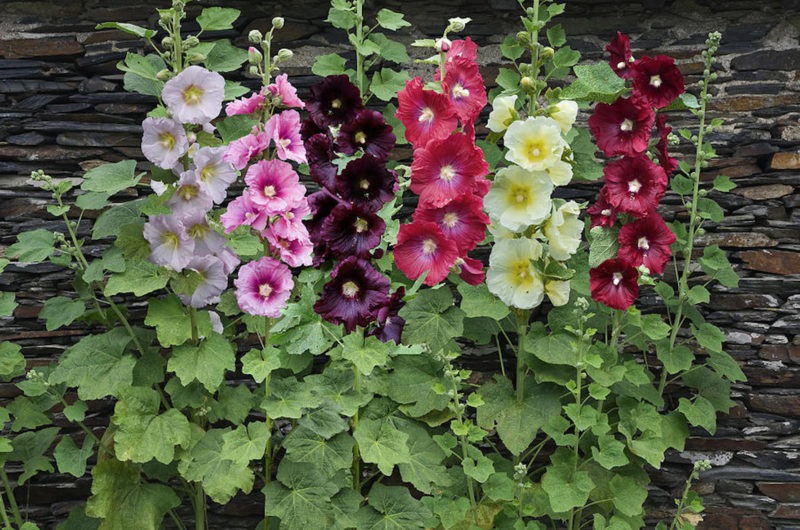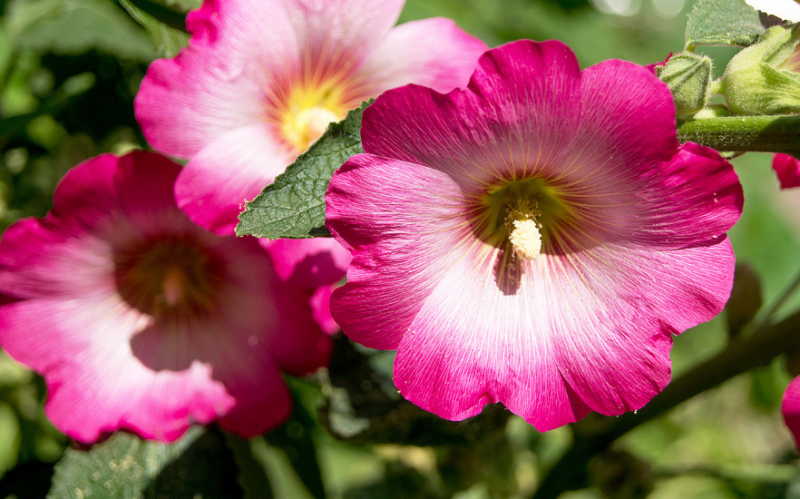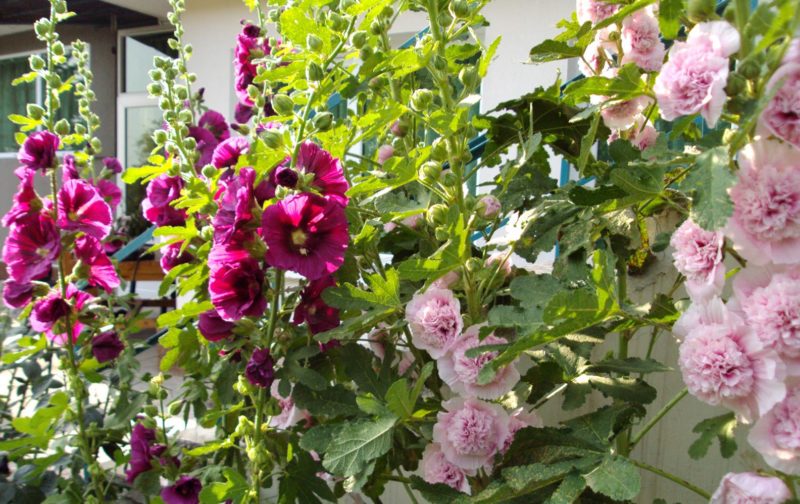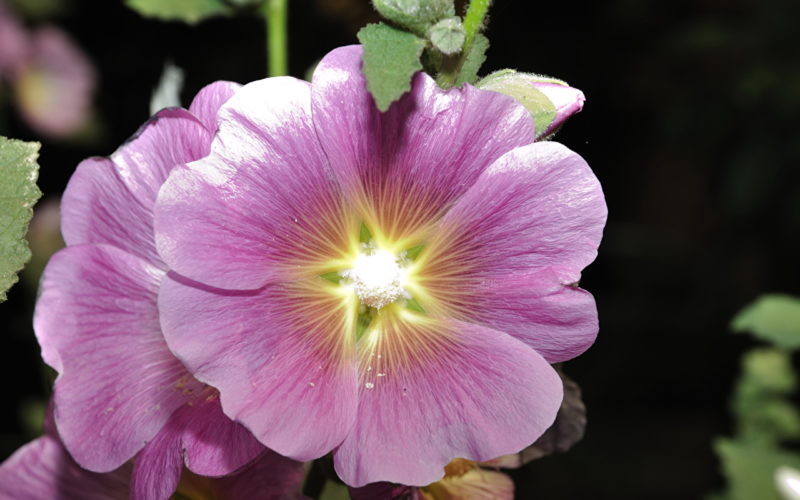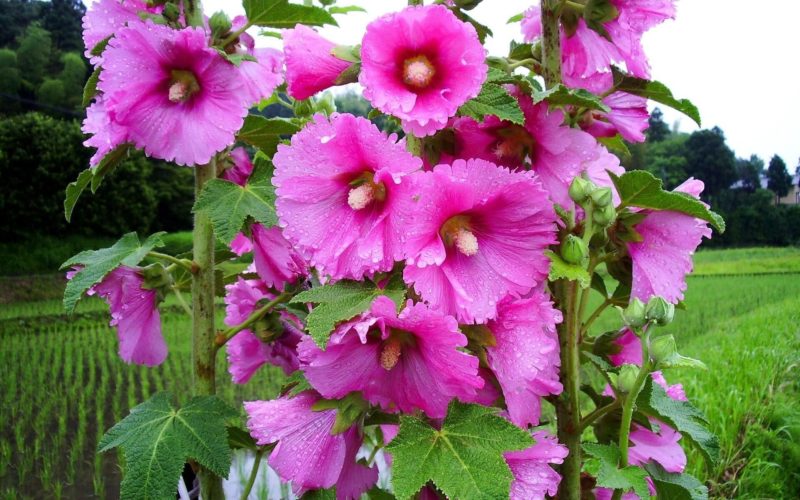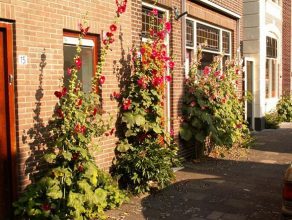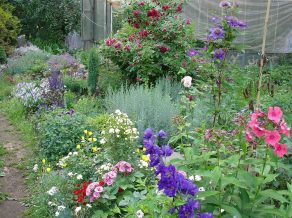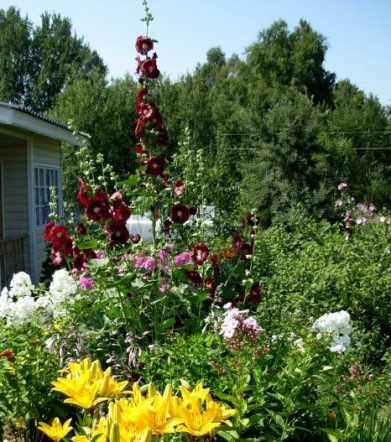At the sight of large, bright shades of flowers in the shape of a glass on a long straight stalk, experienced gardeners exclaim: “Mallows are blooming!” It is important for the owners of the plots to know how to start growing them from seeds and when to plant the rose stem in their own plots. Interest in this decorative plant is now increasing due to the spread of landscape design of gardens and the emergence of new varieties.
Material Content:
Description of roses Stock
“Mallows are blooming” - the name of a romantic story about beauty and love against the backdrop of rural landscapes. These plants a few decades ago were a symbol of a village estate. They bloomed wildly in the front gardens, near walls and fences, accumulating the strength of the earth, the sun and clean air.
The stem rose (Alcea) and its various varieties in the home are called mallow. This plant is not related to rosacea, because it belongs to another family. Malva is an independent genus belonging to the same family Malvaceae.
- Powerful stem-rose stems reach a height of 0.7 - 2 m.
- Leaves up to 10-15 cm wide, with lobes, serrated along the edge, covered with short hairs.
- Flowers are simple or double, 5 - 12 cm in diameter, goblet-shaped, wide-bell-shaped or almost saucer-shaped. When the latter blossom, the fruits of the seeds already ripen in place of the former.
- The color of the corollas is diverse: white with a yellow base, pink with a burgundy center, red with a white core, almost black with a yellow “shaggy” column, and also lilac, lilac and others.
- A powerful inflorescence in the form of a brush has dozens of buds. In total, there are more than a hundred of them per season. They bloom gradually from the beginning of summer until September.
Variety of varieties and species
The natural stem-rose pink species (A. rosea) turned out to be a fertile material for selection. Varieties with a different stem height, large terry cups, and two-color petals were bred.
A brief description of the flowers of popular varieties:
- "Chaters ice" - terry, snow-white with a cream shade; there are Chaters Pink and Chaters Violet.
- Fiesta Time - semi-double, dark pink in the center, lighter on the edge.
- “Cream de Cassis” - terry, light lilac on the edge, purple in the center.
- "Nigra" - simple, dark red, almost black, a column with a stigma yellow.
- "Majorette brown red" - terry, chocolate-burgundy.
- "Margarita" - large, densely, lilac.
- "Summer Carnival" - thick double, bright yellow.
- Peaches and Dreams - terry, light pink.
- "Lyubava" - large, terry, juicy scarlet.
- "Violet" - terry, deep purple with blue.
The "Royal" is also popular. This is a sort mix. Culture is more often used as an annual. It blooms in the year of sowing for a couple of months from the equator of summer. It is stretched to a height of half a meter in height, terry flowers to a decimeter in diameter of all kinds of shades of red.
The culture looks great in group plantings, has found application as a hedge, used for cutting.
In the design of the plots, decorative forms of plants of the genus Malva (Mallow) are used: M. hybrid, stem pink, musky, curly. Breeding is also aimed at creating terry, large-flowered varieties. The similarity of the names makes the confusion: the mallow is stock-pink, and the stock-rose is more commonly called mallow. In addition, there are many subspecies and hybrids.
Coloring of flowers of different species and varieties of mallow (mallow):
- M. Forest "Marina" - simple, lilac-blue with purple stripes in the center.
- Musky Musk “White Perfection”, “Pink Tower” - snow-white or pink.
- M. Forest "Rondell Park" - semi-double, lilac or pale pink.
- M. stock-pink "Fastizhiata" - simple, pink.
The plants under discussion are annuals or perennials. The latter are often grown as biennials. Then they die from the cold in winter or lose their decorative effect.
When to plant seeds for seedlings
Culture successfully propagates vegetatively. However, only sowing seeds makes it possible to obtain a large amount of planting material without much effort. For growing seedlings from seeds, plastic cups, pots, and containers are used. Mallows reproduce without problems by self-sowing.
Biennials are sown in the last month of spring and in June. In the current season, only the basal leaf rosette grows. In the north, containers with seedlings for the winter are transferred to greenhouses or dry, cool rooms. Landing on the site is carried out in the spring.
Varietal groups blooming in the first year are sown from March to April, when warm weather sets in, they are planted in place. In May - June, you can sow in cold greenhouses or in open ground.
The best germination in seeds of a two-year shelf life.
How to get seedlings at home:
- To accelerate germination, the seeds are soaked overnight in warm water.
- Pots are filled with soil consisting of turf land, peat, sand.
- Seeds are spread on the surface of the substrate and sprinkled on top with a thin layer of soil.
- Pots are covered with a film or plastic bag, left in a warm place.
- After the appearance of 2 - 3 leaves, thin out seedlings.
- Regularly spray the soil with warm water.
Germination at a temperature of about 20 ° C occurs within 15 to 20 days. The film is first removed for 10 - 15 minutes, after a few days - for 1 hour. Hardened seedlings are not covered, watered moderately.
Preparing and planting flowers
In spring, seedlings are planted on flower beds, against walls, in well-lit areas, sheltered from strong winds. In the middle lane, stem-rose planting, grown from seeds sown in autumn, is planted in May.Well drained, fertile substrates are preferred.
When digging, enrich the soil with compost, peat, sawdust, and lime if necessary. Seedlings with an earthen lump are planted in prepared holes, the distance between plants is 30-40 cm. Planting is watered, the soil is loosened, and weeds are removed.
The nuances of growing and caring for roses Stock
Mallow trees feel more comfortable in a sunny place. Suitable site near the wall or fence, well-lit in the morning or afternoon. The substrate must be nutritious, well permeable.
Ideal care for the stem rose involves:
- top dressing on poor soils every 4 to 5 weeks, on fertile soils - 2 times;
- regular watering, in the dry period - more frequent;
- installation of supports and garter tall varieties;
- pruning of the stem after flowering to a height of 30 cm;
- mulching with compost on heavy soils.
The biennial life cycle can be extended by cutting off the inflorescence after buds are opened. Then the plant lives as a perennial, if it does not freeze in winter.
Plant diseases and pests
Malvaceous susceptible to damage by fungi. When rust is infected, yellowish-brown or reddish spots appear on the leaves from below. On the outside, they look like discolored patches.
Powdery mildew appears as a bloom of white or grayish color. The disease spreads in humid, warm weather. Affected leaves must be removed. With the spread of fungal infections, fungicides are used. Can be treated with Bordeaux liquid, Topaz.
Withering of a plant occurs when infected with fungi or bacteria, lack of water.
Possible pests:
- spider mite;
- weevil;
- aphid.
The plants are treated with the insecticides Aktara, Aktellik, Vertimek, Decis, Iskra, Fitoverm. It is necessary to use such an amount of the drug that is recommended for spraying flower crops.
Technology of sheltering roses for the winter
Stem-roses - moderately frost-resistant plants. There is a risk of freezing with a thin and uneven snow cover, its periodic melting, and the accumulation of water in depressions.
More attention to warming is required by bushes that did not have enough time to form before frosts. To do this, change care at the end of summer: they feed it with phosphorus-potassium fertilizer and reduce watering.
Biennial and perennial stock roses cover the fallen leaf for the winter. First, the bushes are high up with loose earth. You can use humus or peat, other warming materials. The layer should have a thickness of 15–20 cm.
A more reliable way is to create a small "dome" of fir spruce branches. This material protects plants from being eaten by mice. It is advisable to condense snow next to covered bushes.
Use in landscape design
Stock roses are used in groups, borders, mixborders. Plants are used to decorate walls, create hedges. High flower culture is popular for creating a background in flower beds, as a mask for unsightly places on the site.
Roses are combined with phlox, rudbeckia in cottage and village gardens.
Tall mallows are placed next to buildings not only for decoration. A wall, a fence can serve as a support and protection from the cold. In the evening, the heat accumulated during the sunny day comes from the buildings.
The stem rose is considered unpretentious plant: undemanding to the soil, tolerant of lack of care. Also simple is seed propagation, growing seedlings. With minimal effort, the owner of the site receives magnificent flowers that are not inferior in beauty to peonies and hibiscus.



